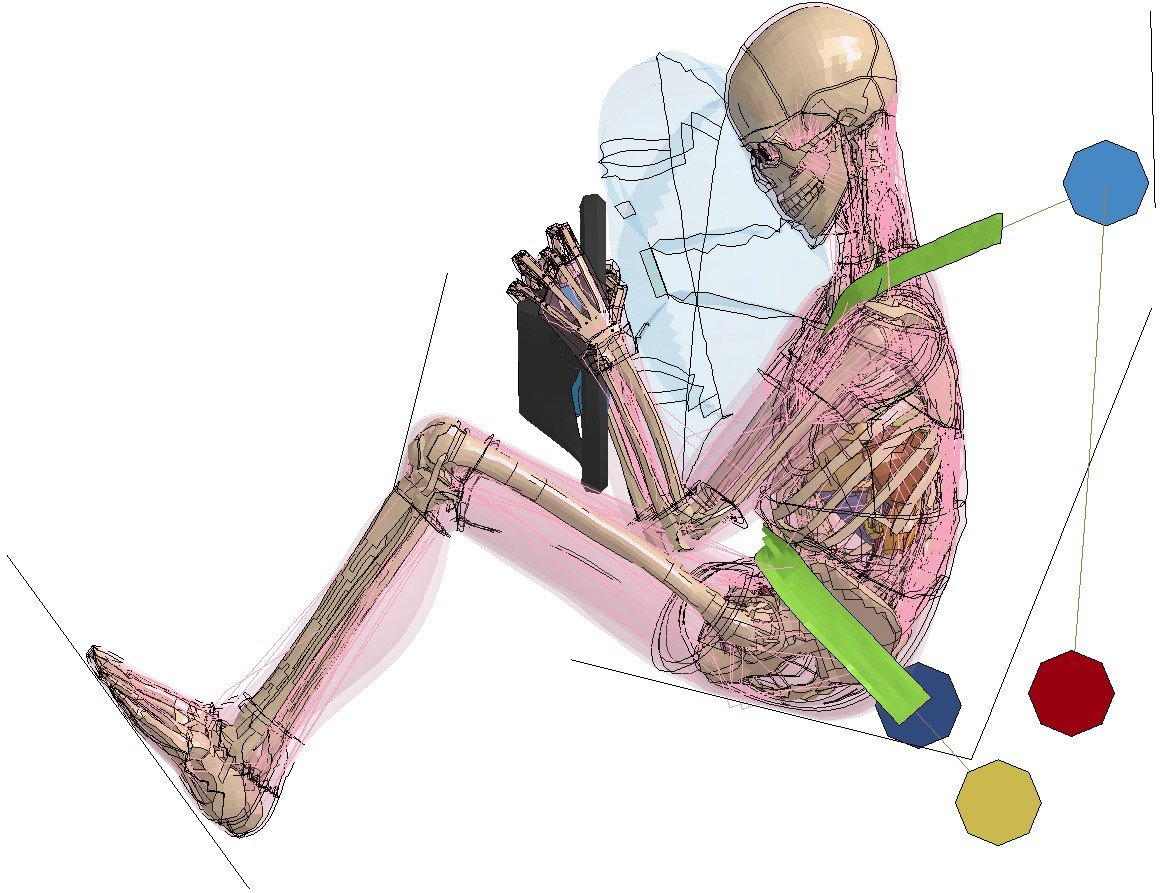
Anyone who has ever seen and even experienced a traffic accident will know: Even if one – hopefully – remained uninjured, one is plagued with sore muscles the next day. The reason: We instinctively prepare for the accident in order to protect ourselves. Just before the collision, people tense their muscles, support themselves on the steering wheel, or perhaps even push the brake pedal through. And finally, it is precisely this behavior that influences the outcome of the accident and the nature and severity of the injuries. Researchers at the Fraunhofer Institute for High-Speed Dynamics, Ernst-Mach-Institute EMI have now for the first time investigated occupant safety on the basis of muscle stiffness using virtual crash test dummies.
Calculation of Movement Shortly Before the Accident
The musculature has a great influence on how a vehicle occupant reacts shortly before an accident and how the body behaves during the crash. This can lead to serious deviations from stiff and kinematically restricted crash test dummies”, explains Dr. Matthias Boljen, a scientist at EMI.
Since the conventional dummies do not have the ability to react, it is not possible to reproduce human behavior shortly before the accident. Therefore, the EMI scientists used a THUMS(TM) v5.01 model (Total Human Model for Safety). This digital computer model can – using a special calculation model for strength and deformation, the so-called FE simulation (Finite Element Simulation) – reproduce the movement of the occupants shortly before an accident.
New Territory in Research
The EMI scientists broke new ground with their research approach to investigating occupant safety on the basis of muscle stiffness. This is because the muscle stiffness associated with contraction and its consequences have not yet been considered. “If a driver supports him- or herself on the steering wheel before the collision, the contraction not only shortens the muscle, but also makes the muscle stiffer. In previous FE simulations of individual muscles and muscle groups of entire human models, contraction was completely ignored”, explains Boljen.

The lead picture of this article shows an offset crash in the tense muscle condition of THUMS. The possible challenges for passive safety in an accident scenario deviating from the frontal crash become clear: The longitudinal seatbelt slips.
The above picture also simulates a frontal crash in the tense muscle condition of the human model THUMS. Through active muscle contraction, THUMS holds on to the steering wheel and supports itself during the impact of the crash. This potentially relieves the chest. The colored octahedrons make the various buckle points of the modelled seat belt visible.
Further Development of the Human Models
Together with his colleague Niclas Trube, Boljen defined four different stiffness states on the THUMS model. The two examined the influence of these changes on a simulated frontal crash. The result: muscle stiffness has a decisive influence on the behavior of the vehicle occupants. Depending on the degree of stiffness, different injuries can be expected in an accident.
This insight could be of great importance for the further development of human models, especially with regard to autonomous driving. Vehicle interiors will be redesigned in the future, so existing concepts for seat belts and airbags will also have to be reconsidered. Human models are a valuable tool here”, Trube is convinced.
Traffic Safety Requirements
The human models can also be used to protect pedestrians and cyclists. Current studies show that there is a need for action here. According to the ADAC, the number of killed car occupants and pedestrians has fallen slightly, but the number of killed cyclists has risen. This may be due to an accumulation of surprisingly dangerous situations caused by e-bikes. In addition, e-scooters, scooters with electric motors, will be allowed on public roads this year. Traffic experts thus worry about a further increase in accidents. Human models can be used to investigate accident scenarios in advance. Depending on collision behavior, the frequency and intensity of the accidents can be tested. Manufacturers of protectors, helmets and other protective equipment could benefit from the recommendations.
Virtual Human Models Also Interesting for Medicine
How the human body reacts to mechanical stress is not only relevant for the transport sector, but also for medical and ergonomic issues. For example, it is certainly relevant to know how materials from implants and prostheses behave in relation to human bones if, for example, they are suddenly subjected to stress as a result of an accident? Or how the vibrations of tools affect the user. “This is where human models come in, because we can use them to create realistic virtual images that cannot be realized experimentally”, says Boljen.








